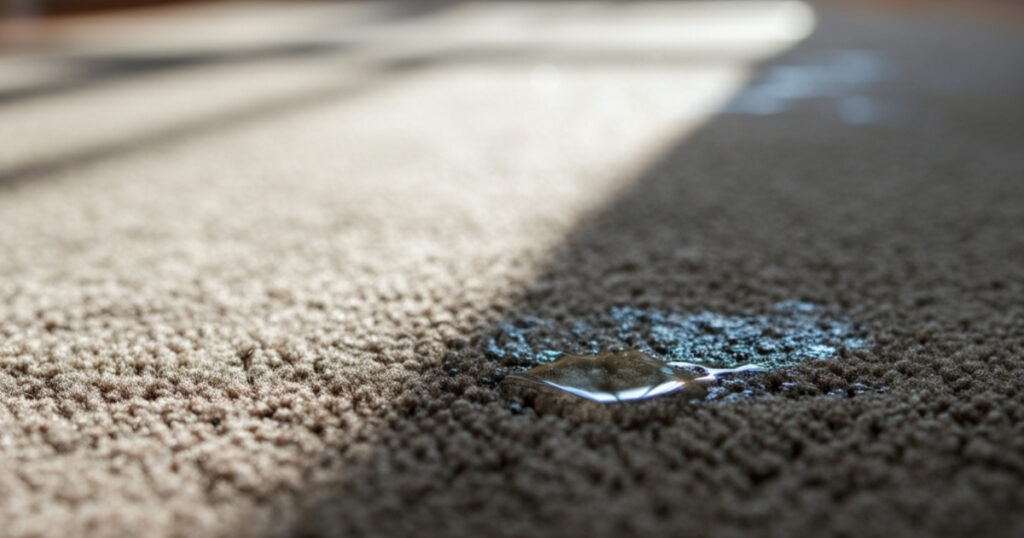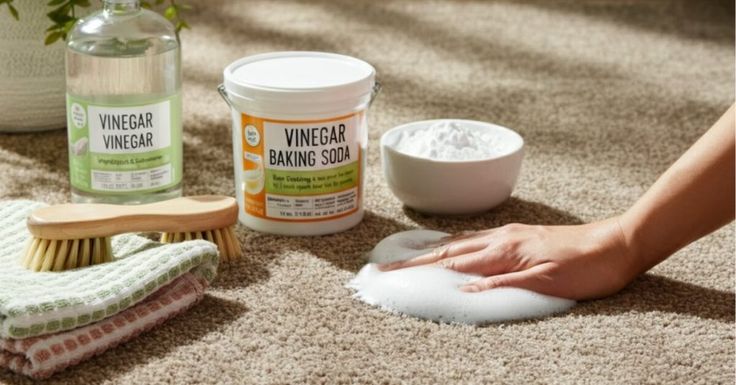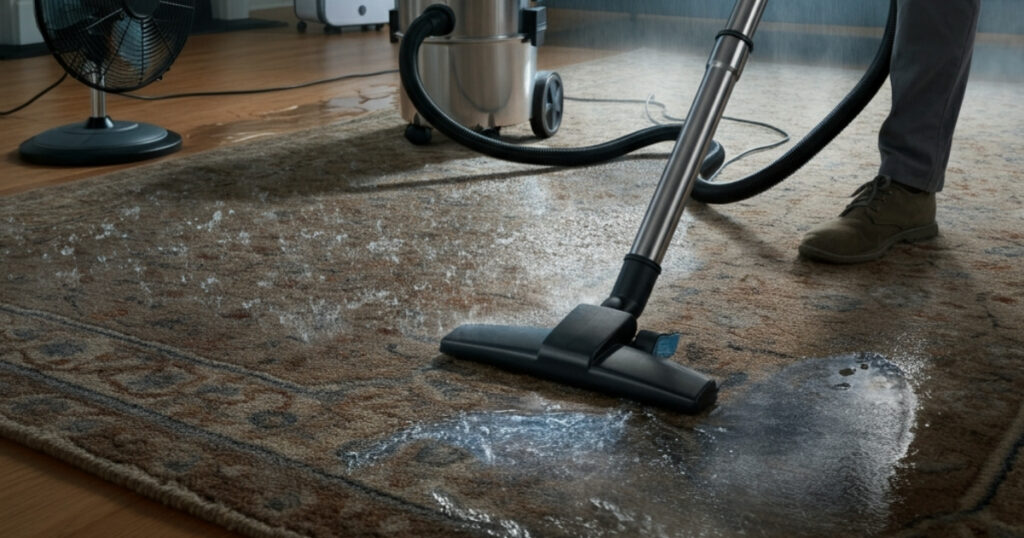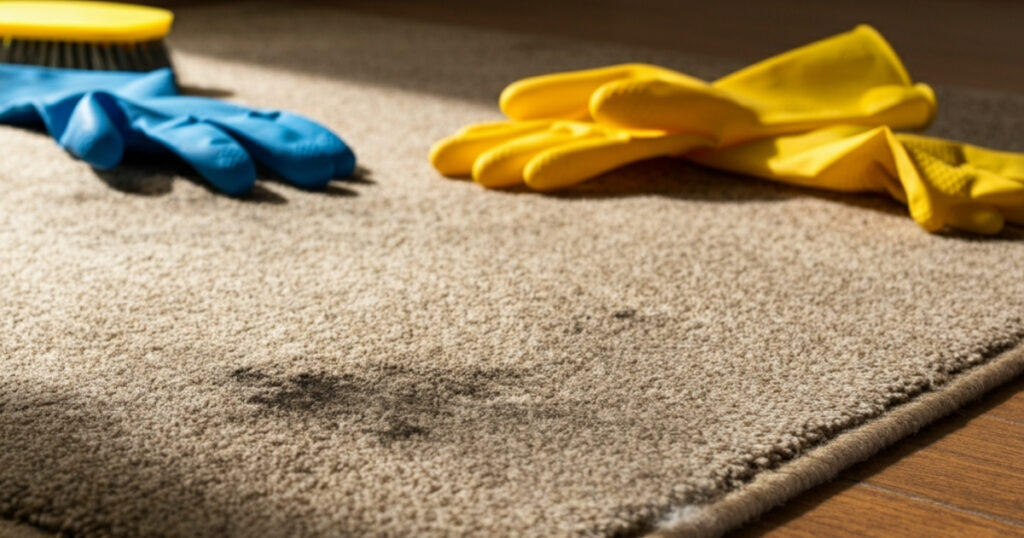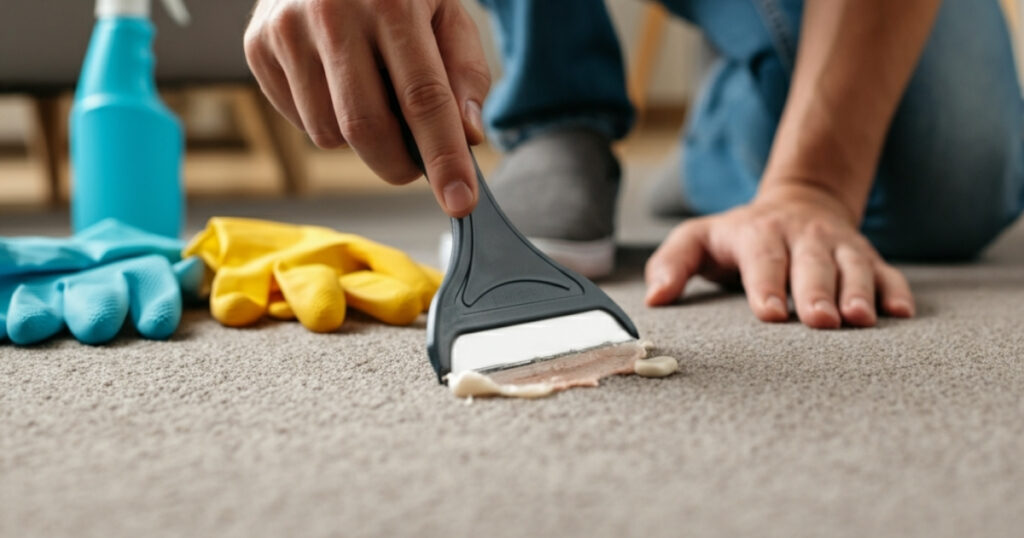As an Amazon Associate, I earn from qualifying purchases.
Finding a mysterious wet spot on your carpet can be unsettling. You haven’t spilled anything, and it hasn’t rained, yet there’s a damp patch that seems to have appeared from nowhere. If you’re wondering why is my carpet wet in one spot, you’re not alone. This common household issue often points to a hidden problem that needs immediate attention. Ignoring it can lead to mold growth, structural damage, and unpleasant odors.
This guide will walk you through the common causes of isolated wet spots on your carpet. Moreover, we will provide a step-by-step process to identify the source of the leak, dry the affected area properly, and prevent it from happening again. By understanding the potential culprits and knowing how to act, you can protect your home and your health.
Contents Overview
Common Reasons for a Wet Carpet Spot
An isolated wet spot on your carpet is almost always a sign of a leak. The challenge is figuring out where the water is coming from. The source could be hidden within your walls, under your floor, or even in the ceiling above. Let’s explore the most frequent causes.
Leaking Pipes
One of the most common reasons for a mysterious wet patch is a leaking pipe. Your home has a complex network of plumbing for water supply and drainage, and even a small leak can create a significant problem over time.
- Supply Lines: These are pressurized pipes that carry clean water to your faucets, toilets, and appliances. A pinhole leak in a supply line can spray or drip water continuously, which then soaks into the subfloor and eventually appears on your carpet.
- Drain Lines: These pipes carry wastewater away. While they aren’t pressurized, a crack or loose joint can allow water to seep out, especially when a nearby sink, shower, or toilet is used.
Foundation Leaks (Slab Leaks)
If your home is built on a concrete slab foundation, the plumbing lines may run underneath or within the concrete. A leak in one of these pipes is known as a slab leak. This is a serious issue because the water has nowhere to go but up.
The water will saturate the concrete and then seep into the carpet padding and fibers from below. Because the leak is under the floor, the wet spot on the carpet is often the very first sign of trouble. Slab leaks require professional detection and repair.
Roof or Ceiling Leaks
Is the wet spot located under an upper-floor bathroom or directly below the roof? The source might be from above.
- Roof Damage: A damaged shingle, compromised flashing, or a clogged gutter can allow rainwater to penetrate your roof and attic. From there, it can travel along rafters and joists before dripping onto the ceiling and soaking the carpet below.
- HVAC System Leaks: Your air conditioning unit’s drain line can become clogged, causing water to back up and overflow from the drain pan. If your HVAC unit is in the attic, this overflow can leak through the ceiling and onto your carpet.
Appliance Malfunctions
Household appliances are another frequent source of localized water damage. Check any appliances located near the wet spot.
- Refrigerators: The water line connected to an ice maker or water dispenser can leak.
- Dishwashers and Washing Machines: Hoses can crack, or connections can loosen over time, leading to slow drips or major leaks.
- Water Heaters: These tanks can corrode and develop slow leaks at the base, often going unnoticed until the water reaches a nearby carpeted area.
Pet Accidents
Before you start tearing down walls, consider a simpler explanation. If you have pets, an accident could be the cause. Pet urine can soak deep into the carpet and padding, and even after it dries on the surface, the moisture trapped underneath can make the spot feel damp, especially in humid conditions. An ammonia-like smell is a tell-tale sign of a pet-related issue.
How to Find the Source of the Wet Spot
Now that you know the potential causes, it’s time to play detective. Finding the source is crucial for a permanent fix.
Step 1: Check the Obvious First
Start with the simplest explanations.
- Feel the spot: Is it truly just water, or does it feel soapy or sticky? Does it have an odor? A foul smell might indicate a sewage line leak, while a chemical smell could point to an appliance.
- Look Up: Examine the ceiling directly above the wet spot for any discoloration, stains, or signs of moisture.
- Check Nearby Appliances: Inspect all appliances in the vicinity. Look for puddles, drips, or signs of corrosion around water lines and hoses.
Step 2: Pull Back the Carpet
If the source isn’t obvious, you’ll need to look underneath the carpet.
- Using a pair of pliers, carefully grab a corner of the carpet nearest to the wet spot.
- Gently pull the carpet up and away from the tack strip at the edge of the wall.
- Peel it back far enough to expose the padding and subfloor underneath the damp area.
Step 3: Inspect the Padding and Subfloor
With the carpet pulled back, you can gather more clues.
- Examine the Carpet Padding: Is the padding soaked? Often, the padding will be much wetter than the carpet itself, indicating the water is coming from below.
- Inspect the Subfloor: Look at the subfloor (the wood or concrete base). Can you see a clear water trail? Is the subfloor discolored, soft, or showing signs of mold? If the subfloor is concrete, look for cracks or dark, damp areas that could signal a slab leak.
Step 4: Use a Moisture Meter
For a more scientific approach, a moisture meter can help you trace the water to its source. These devices measure the moisture content in materials.
- Start at the center of the wet spot and take a reading.
- Move the meter in all directions, taking readings every few inches.
- The moisture levels should increase as you get closer to the source of the leak. Follow the path of highest moisture to pinpoint the origin.
How to Properly Dry a Wet Carpet Spot
Once you’ve identified and fixed the leak, you must dry the carpet thoroughly. Simply letting it “air dry” is not enough and can lead to mold and mildew. Time is critical; you should begin the drying process within 24-48 hours.
Step 1: Extract as Much Water as Possible
The first goal is to remove the bulk of the water.
- Use a Wet-Dry Vacuum: A wet-dry shop vac is the best tool for this job. Go over the wet area slowly and repeatedly to suction out as much water as you can. Do not use a regular household vacuum, as this can cause electrical shock and ruin the machine.
- Blot with Towels: After vacuuming, press down firmly on the area with thick, dry towels to absorb remaining moisture. Replace the towels as they become saturated.
Step 2: Remove the Carpet Padding
In almost all flood or leak situations, the carpet padding should be replaced. It acts like a sponge and is nearly impossible to dry completely once soaked.
- Cut out the wet section of the padding with a utility knife.
- Remove it and allow the subfloor underneath to dry fully.
- You can purchase a replacement piece of padding from a home improvement store to install later.
Step 3: Create Airflow to Dry the Carpet and Subfloor
Proper air circulation is essential for evaporating the remaining moisture.
- Lift the Carpet: Prop up the wet section of the carpet so air can circulate underneath it. You can use a wooden block or another object to hold it up.
- Use Fans: Position several high-powered fans to blow air directly across the top of the carpet and onto the exposed subfloor. Create cross-ventilation by opening windows if the outdoor humidity is low.
- Use a Dehumidifier: Place a dehumidifier in the room to pull moisture out of the air. This speeds up the drying process and prevents moisture from settling elsewhere. Empty the dehumidifier’s collection tank frequently.
Step 4: Sanitize and Deodorize the Area
After the carpet and subfloor are completely dry, you need to treat the area to prevent mold growth and eliminate odors.
- Apply an Antimicrobial Solution: Spray the carpet, subfloor, and surrounding area with a carpet-safe antimicrobial treatment. This will kill any lingering mold spores and bacteria.
- Clean the Carpet: Use a carpet cleaner or hot water extractor with a suitable cleaning solution to deep clean the affected spot. This helps remove any dirt and residue left behind by the water.
- Deodorize: Sprinkle baking soda over the dry carpet, let it sit for a few hours, and then vacuum it up to absorb any remaining odors.
When Should You Call a Professional?
While some minor leaks can be a DIY fix, certain situations require professional help.
- Large Wet Area: If the wet spot is larger than a few square feet, it’s best to call a water damage restoration company. They have commercial-grade equipment to dry the area quickly and effectively.
- Contaminated Water: If you suspect the water is from a sewage line (black water), do not attempt to clean it yourself. This water contains harmful bacteria and requires professional handling.
- Signs of Mold: If you see or smell mold, contact a mold remediation specialist. Improperly handling mold can spread spores throughout your home.
- Slab Leaks: Diagnosing and repairing a slab leak is a complex job that should always be left to a professional plumber.
Protecting Your Home From Future Leaks
Finding a single wet spot on your carpet is often a warning sign. Regular maintenance is the best way to prevent future issues.
- Inspect Hoses and Pipes: Periodically check the hoses on your washing machine, dishwasher, and refrigerator for cracks or bulges.
- Know Your Water Main: Make sure you know where your home’s main water shut-off valve is located in case of a major leak.
- Monitor Your Water Bill: An unexplained spike in your water bill is a strong indicator of a hidden leak.
By being proactive, you can catch small problems before they turn into costly disasters.
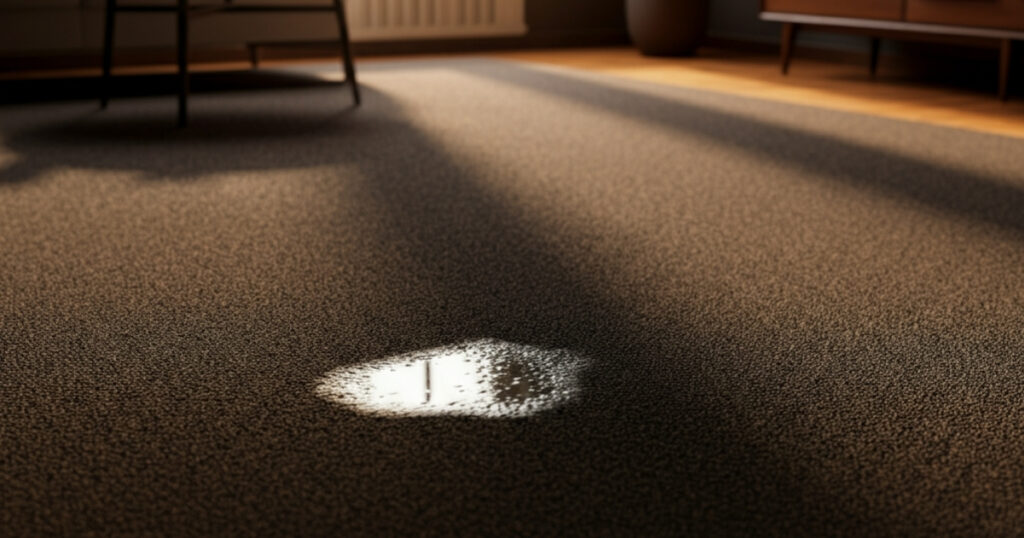
Frequently Asked Questions
1. Can a wet carpet dry on its own?
No, a wet carpet will not dry properly on its own. The padding and subfloor will remain damp, creating a perfect environment for mold and mildew to grow within 24-48 hours. Active drying with fans and dehumidifiers is essential.
2. How long does it take for mold to grow in a wet carpet?
Mold can begin to grow in a wet carpet in as little as 24 to 48 hours, especially in warm and humid conditions. This is why quick action is so important.
3. What does a slab leak look like on a carpet?
A slab leak typically appears as a damp or soaked spot on the carpet that has no other obvious source. You might also notice a musty smell, warm spots on the floor, or the sound of running water when no faucets are on.
4. Is it safe to use a regular vacuum on a wet carpet?
No, it is not safe. Using a standard household vacuum on a wet carpet poses a serious risk of electrical shock and will likely destroy the vacuum’s motor. Always use a vacuum specifically designed for water extraction, such as a wet-dry shop vac.
5. How do I know if my carpet is completely dry?
To be certain, use a moisture meter. A reading below 20% generally indicates it is dry enough. If you don’t have a meter, press a dry paper towel firmly against the carpet for 30 seconds. If the towel remains dry, the carpet is likely ready.
As an Amazon Associate, I earn from qualifying purchases.

